Armo's 1/35 Izorski Fiat
WWI Russian Armored Car | 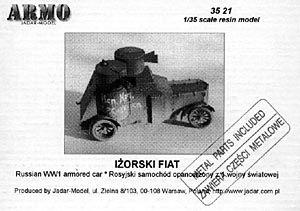 | History The Imperial, and later Soviet, Russian armored car needs were met first by ordering and importing complete cars from other countries, primarily England. Eventually, because so many modifications were made to the foreign products, the Russians turned to ordering the chassis only and building their own bodies. Beginning about 1916, the Italian Fiat company supplied a conventional touring car chassis with pneumatic tires, doubled at the rear to carry the additional weight; and the armor was fitted to them in the Izorski factory. It is no accident that this car strongly resembled the British Austins which were acquired in significant numbers by the Russians; apparently they preferred the double turret design over other configurations. Approximately 74 of the Izorski-Fiat cars were built and they were used by the Soviet army through the 1920's. A few were captured by the Germans during WWI, and several more found themselves in the Finnish and Polish armies in the early 20's. At least two Polish-captured Izorski-Fiats were used against the Russians in 1920, one of which was named 'General Dowbor' in honor of the Commander-in-Chief of the Polish forces in the Wielkopolski Uprising against the Germans in 1919. 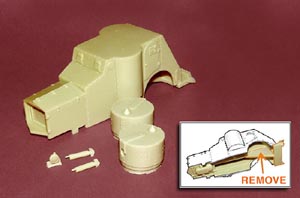 The Kit The Kit
Another stellar effort by ARMO of Warsaw, Poland, this was in fact the first of four WWI armored car kits produced by them in the last two years. This kit is so beautifully mastered and cast that it would make an ideal first effort into the land of resin and photoetch. Packaged as usual in a thin but sturdy corregated cardboard box, the box art is perhaps the only place where ARMO could use some improvement: a photo of the completed model is printed in a coarsely-screened, black and white, 2 1/4 by 3 inch version on the cover and postage stamp size on the box end. Not a big help, but inexpensive, I'd guess. Opening the box reveals two bubble-wrapped bundles, a flat plastic bag with a PE fret by Part (also of Poland), and one double-sided page of instructions. 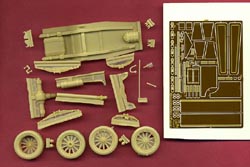 The instructions consist of two very well done exploded view drawings: one of these is the underside and the other is the typical 3/4 view of the side, top, and front. The usual historical notes are in Polish only, but there are two or three other sentences that are also in English. One side refers to this car as "Armstrong-Whitworth-Fiat (Izorski Fiat)"--I don't have a clue what the "Armstrong-Whitworth" connection is. The resin parts are not numbered or otherwise identified, but there is no chance of confusion; the PE parts are numbered on the instructions and the brass fret--a big dzienkuje [thank you] to ARMO for that since many of these are not easily identifiable. The instructions, then, are minimal but they get the job done. Frankly, I prefer pictures over written instructions--in the increasingly global market for model kits, drawings are far better than "...attach the wide end of part 37 between the two triangular flanges at the front of part 4 taking care to keep part 22..."--well, you know what I mean! The instructions consist of two very well done exploded view drawings: one of these is the underside and the other is the typical 3/4 view of the side, top, and front. The usual historical notes are in Polish only, but there are two or three other sentences that are also in English. One side refers to this car as "Armstrong-Whitworth-Fiat (Izorski Fiat)"--I don't have a clue what the "Armstrong-Whitworth" connection is. The resin parts are not numbered or otherwise identified, but there is no chance of confusion; the PE parts are numbered on the instructions and the brass fret--a big dzienkuje [thank you] to ARMO for that since many of these are not easily identifiable. The instructions, then, are minimal but they get the job done. Frankly, I prefer pictures over written instructions--in the increasingly global market for model kits, drawings are far better than "...attach the wide end of part 37 between the two triangular flanges at the front of part 4 taking care to keep part 22..."--well, you know what I mean! 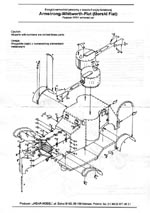 One of the bundles holds the resin body of the car, cast in one piece, as well as two solid cast turret tops. One look at these tells you you're dealing with a quality product. The resin is a hard, dense, light ochre color and the pieces are cast with only very minor flaws or overruns. The edges are crisp and sharp and the rivet/hinge/relief details are perfect. All three parts have resin carriers which will have to be removed, but they all require sawing a straight line and should pose no problem whatsoever. A glance inside the body reveals a very clever little touch: there is a 'wall' down the middle from front to back which ensures that the hollow body casting remains rigid; a thinner triangular section of this 'wall' at the rear must be removed to install the frame/underside piece and the remaining 'wall' then serves as a locator for snapping the underside piece right into the correct position. Sweet! One of the bundles holds the resin body of the car, cast in one piece, as well as two solid cast turret tops. One look at these tells you you're dealing with a quality product. The resin is a hard, dense, light ochre color and the pieces are cast with only very minor flaws or overruns. The edges are crisp and sharp and the rivet/hinge/relief details are perfect. All three parts have resin carriers which will have to be removed, but they all require sawing a straight line and should pose no problem whatsoever. A glance inside the body reveals a very clever little touch: there is a 'wall' down the middle from front to back which ensures that the hollow body casting remains rigid; a thinner triangular section of this 'wall' at the rear must be removed to install the frame/underside piece and the remaining 'wall' then serves as a locator for snapping the underside piece right into the correct position. Sweet! The second bundle contains a plastic bag holding all the little fiddly bits, wheels, axles, springs, machine guns, etc. If you check the photo, you'll see there is a little flash between the spokes of the wheels, and any part longer than half an inch has its carrier still attached, helping to keep it straight. The four wheels (double on the rear) have the most serious flaws--a short section of tread on each one is rough and will need some delicate filler and sanding work. If you don't want to do this, you could just put that part of the wheel on some muddy ground (of which Russia surely has the world's greatest supply :-). On the other hand, you'll also see the remarkable level of detail captured in the resin: twelve tiny bolts on each wheel hub, individual leaves in the springs--the mind boggles! 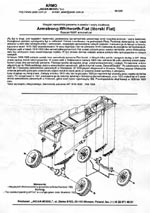 And to top it all off, there's a Part PE fret with about 65 large to minute parts to dress up the exterior of the car. At least 20 of these little jewels are 'wing' screws which apparently were used to secure the armored engine panels. Lots of fender brackets and the fenders themselves, the radiator doors and all their hardware, and the 'flaps' sheltering the two machine guns are some of the more obvious PE parts. This fret is double etched with lots of bolts in relief and is a virtual work of art in itself. And to top it all off, there's a Part PE fret with about 65 large to minute parts to dress up the exterior of the car. At least 20 of these little jewels are 'wing' screws which apparently were used to secure the armored engine panels. Lots of fender brackets and the fenders themselves, the radiator doors and all their hardware, and the 'flaps' sheltering the two machine guns are some of the more obvious PE parts. This fret is double etched with lots of bolts in relief and is a virtual work of art in itself.
The accuracy of all this is difficult to evaluate, since there is very little information (in any language) about this Russian car. A few poor photos in Polish and Russian books is about it. The kit precisely matches GA drawings in Russian Armored Cars (published in Russian) and I guess that's as good a source as any. If anyone knows of other reference sources, please forward them to this reviewer. The box art shows the model with an inscription on the side in Russian, but no decals are included to replicate this. Painting notes consist of basically, "paint it green" (Humbrol 150 is suggested by ARMO but any dark OD or dark green would do nicely). Conclusion This is a beautifully done kit of an obscure Italian/Russian-manufactured vehicle. As such it will have limited appeal, but ARMO has done its best to produce a kit that will fill a good number of enjoyable, hassle-free hours and result in a stunning OOB model. Keep up the good work, ARMO, and let's see more WWI era vehicles--a Russian Packard or Lanchester would be a nice Christmas present... The kit is available from Jadar-Model, Warsaw, Poland, for US $37.05. | 







|

 The Kit
The Kit The instructions consist of two very well done exploded view drawings: one of these is the underside and the other is the typical 3/4 view of the side, top, and front. The usual historical notes are in Polish only, but there are two or three other sentences that are also in English. One side refers to this car as "Armstrong-Whitworth-Fiat (Izorski Fiat)"--I don't have a clue what the "Armstrong-Whitworth" connection is. The resin parts are not numbered or otherwise identified, but there is no chance of confusion; the PE parts are numbered on the instructions and the brass fret--a big dzienkuje [thank you] to ARMO for that since many of these are not easily identifiable. The instructions, then, are minimal but they get the job done. Frankly, I prefer pictures over written instructions--in the increasingly global market for model kits, drawings are far better than "...attach the wide end of part 37 between the two triangular flanges at the front of part 4 taking care to keep part 22..."--well, you know what I mean!
The instructions consist of two very well done exploded view drawings: one of these is the underside and the other is the typical 3/4 view of the side, top, and front. The usual historical notes are in Polish only, but there are two or three other sentences that are also in English. One side refers to this car as "Armstrong-Whitworth-Fiat (Izorski Fiat)"--I don't have a clue what the "Armstrong-Whitworth" connection is. The resin parts are not numbered or otherwise identified, but there is no chance of confusion; the PE parts are numbered on the instructions and the brass fret--a big dzienkuje [thank you] to ARMO for that since many of these are not easily identifiable. The instructions, then, are minimal but they get the job done. Frankly, I prefer pictures over written instructions--in the increasingly global market for model kits, drawings are far better than "...attach the wide end of part 37 between the two triangular flanges at the front of part 4 taking care to keep part 22..."--well, you know what I mean!  One of the bundles holds the resin body of the car, cast in one piece, as well as two solid cast turret tops. One look at these tells you you're dealing with a quality product. The resin is a hard, dense, light ochre color and the pieces are cast with only very minor flaws or overruns. The edges are crisp and sharp and the rivet/hinge/relief details are perfect. All three parts have resin carriers which will have to be removed, but they all require sawing a straight line and should pose no problem whatsoever. A glance inside the body reveals a very clever little touch: there is a 'wall' down the middle from front to back which ensures that the hollow body casting remains rigid; a thinner triangular section of this 'wall' at the rear must be removed to install the frame/underside piece and the remaining 'wall' then serves as a locator for snapping the underside piece right into the correct position. Sweet!
One of the bundles holds the resin body of the car, cast in one piece, as well as two solid cast turret tops. One look at these tells you you're dealing with a quality product. The resin is a hard, dense, light ochre color and the pieces are cast with only very minor flaws or overruns. The edges are crisp and sharp and the rivet/hinge/relief details are perfect. All three parts have resin carriers which will have to be removed, but they all require sawing a straight line and should pose no problem whatsoever. A glance inside the body reveals a very clever little touch: there is a 'wall' down the middle from front to back which ensures that the hollow body casting remains rigid; a thinner triangular section of this 'wall' at the rear must be removed to install the frame/underside piece and the remaining 'wall' then serves as a locator for snapping the underside piece right into the correct position. Sweet!  And to top it all off, there's a Part PE fret with about 65 large to minute parts to dress up the exterior of the car. At least 20 of these little jewels are 'wing' screws which apparently were used to secure the armored engine panels. Lots of fender brackets and the fenders themselves, the radiator doors and all their hardware, and the 'flaps' sheltering the two machine guns are some of the more obvious PE parts. This fret is double etched with lots of bolts in relief and is a virtual work of art in itself.
And to top it all off, there's a Part PE fret with about 65 large to minute parts to dress up the exterior of the car. At least 20 of these little jewels are 'wing' screws which apparently were used to secure the armored engine panels. Lots of fender brackets and the fenders themselves, the radiator doors and all their hardware, and the 'flaps' sheltering the two machine guns are some of the more obvious PE parts. This fret is double etched with lots of bolts in relief and is a virtual work of art in itself. 






